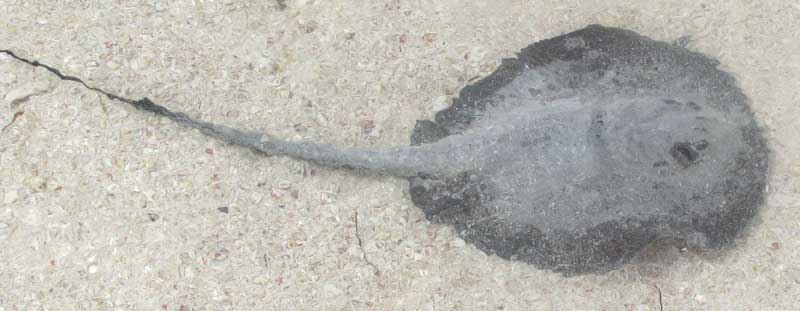Excerpts from Jim Conrad's
Naturalist Newsletter

from the December 29, 2008 Newsletter issued from Mayan Beach Garden Resort 20 kms north of Mahahual; Caribbean coastal beach and mangroves, ~N18.89°, ~W87.64°, Quintana Roo state, MÉXICO
STINGRAYS
For a couple of days it'd been unusually hot, humid and fairly calm, so that biting gnats called Chaquistas were making working outside a bit hard. But then a norte began blowing in, bringing intermittent showers, temperatures down in the upper 70s and a broody feeling out over the ocean. Maybe that's why on my walk that day I saw things not normally seen. A big flock of parakeets spun overhead; a Peregrine Falcon flew right over my head not 15 feet high, and; stingrays appeared in shallow water right next to the shoreline. You can see a 15-inch-wide one of those above.
First of all, are stingrays "fish?" In the old days when textbooks spoke of "the Class Pisces," or "the taxonomical Class of Fishes," it was easier to say. However, nowadays gene sequencing has revealed that kinds of animals we think of as fishes are so scattered throughout the phylogenetic Tree of Life that, if we consider the various branches including species we think of as fish, some of the taxa in any given branch very well may include four- legged animals that definitely we don't think of as "fish." In other words, the concept of "fish" isn't sound in a technical, taxonomical sense.
However, using the term "fish" in a traditional way, we can say that ray-fish are indeed fish. They're "cartilaginous fish" (as opposed to bony fish), which groups them with sharks and skates.
What's the difference between a stingray and a Manta Ray? One definition of a stingray is that it's a member of the Stingray Family, the Dasyatidae. Manta Rays belong to this family, so manta rays also can be regarded as stingrays. Manta rays might be defined as species in the genus Manta, a genus famous for including some of the largest rays. One could say, then, that all mantas are stingrays, but not all stingrays are mantas.
Stingrays bear razor-sharp stingers, or saw-toothed spines, which grow from their whip-like tails like fingernails. Two grooves containing venom-secreting glands occur below the spines. Stingray "wings" are actually large pectoral fins. Many ray-fish lack stingers. Their rear ends look like the rear ends of regular fish. In fact, when you have a lot of pictures of cartilaginous fish before you, you can arrange them so that there's a fairly smooth gradation from cylinder-bodied sharks to flat-bodied ray-fish.
I'm unsure which species appears in my photograph, but I'm leaning toward calling it the Southern Stingray, DASYATIS AMERICANA*
*UPDATE: In 2024 I upload the image of our stingray to iNaturalist where user "diegoalmendras" recognizes the Caribbean Whiptail Stingray, STYRACURA SCHMARDAE. The two species are very similar, but the front part of Hypanus americanus tends to be somewhat pointy, while that of Styracura schmardae is more rounded, as seen on our photos.
from the July 3, 2011 Newsletter issued from Mayan Beach Garden Inn 20 kms north of Mahahua, Quintana Roo, México
STORM STINGRAYS
Early this week as Tropical Storm Arlene formed in the Bay of Campeche across the peninsula from us, we had continual winds strong enough to push a fellow on his bicycle, and to form waves that looked dramatic coming ashore. Maybe that's why this week stingrays suddenly showed up in very shallow water next to the beach. I've heard local fishermen talk about the wind blowing new fish into the area. "We're all fished out here inside the reef," they complain. "We need a good storm to blow in a new crop of big ones for us."
So, there were two rays, both about a foot across, right at the water's edge, in water so shallow they almost got stranded when the waves were out. One stingray was positioned atop the other and I figured they were mating. When I got close for a picture they separated. You can see one of them then below:

I figure that this is the Southern Stingray occurring in the western Atlantic from New Jersey to southern Brazil. I read that adults reach 6.5 feet across (2m), so what were these two juveniles doing, one atop the other?
I read that Southern Stingrays are mostly nocturnal and feed on bivalves, worms, crustaceans and small fish. They feed by flapping their wings to stir up sand, exposing their prey.
In fact, stirring up sand seems to be important to these fish. As the stingray in the picture was swimming around my feet I moved a little, apparently scaring him. He quivered in such a way that sand billowed up covering him so uniformly that when it settled he was practically invisible. In fact, I took a picture of his camouflaged position but when I put the image onto my laptop's screen I couldn't find him.